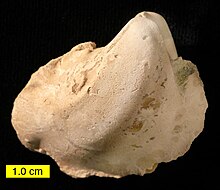Trigoniidae
Although they were abundant in the Mesozoic era, they are today represented by only one living genus, Neotrigonia, which inhabits waters off the coast of southern Australia.
Etheldred Benett added several Upper Jurassic species, although her work was not primarily recognised due to the academic status of women at that time.
The major worker on the Trigoniidae in the nineteenth century was John Lycett, a physician from Gloucestershire who published a text entitled A Monograph of British Fossil Trigoniae.
Today, knowledge is sufficient to divide the family into five Subfamilies (see below), which together contain more than sixteen genera, the most abundant being Trigonia, Myophorella, Laevitrigonia, and Orthotrigonia.
The hinge structure is amongst the most complex of all bivalves, namely that the teeth are numerous and ridge-like with strong transverse striations.
In Britain, examples are numerous in the Upper Jurassic rocks of the Dorset coast, particularly around the village of Osmington Mills.
The genus Trigonia is the most readily identifiable member of the family, having a series of strong ribs or costae along the anterior part of the shell exterior.
The first European examples (Trigonia costata Parkinson) turn up in the Lower Jurassic (Toarcian) of Sherborne, Dorset and Gundershofen, Switzerland.



